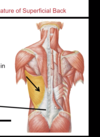Superficial and deep back lecture Flashcards
(62 cards)
What is a functional difference between superficial back muscles and deep back muscles?
Superficial back muscles act on upper limbs, and deep back muscles act on vertebral column (i.e. keep spine erect despite weight of internal organs)
How many vertebrae are in the vertebral column? How many cervical, thoracic, lumbar, sacral, and coccygeal?



What are the two type of joints in the vertebral column that allow for stability and some movement? Which allows for the most movement?
Synovial (diarthroidal) and cartilaginous joints. Synovial joints most moveable
What is this?

Articulation between superior and inferior articulating processes of vertebrae in a synovial joint (facet joint)
What is this? What does it do?


What herniates when you have a herniated disk?
The nucleus pulposus



What is the only remnant of the notochord in adults?
Nucleus pulposus
Why does a herniated disk cause radicular pain?
Because it presses on a true spinal root

What is a sciatica?

What does L5 radiculopathy cause?
weak dorsiflexion (moving foot up toward shin) of foot and toes
What does S1 radiculopathy cause?
depressed anke reflex and weakness of plantar flexion of foot
plantar flexion is a movement in which the top of your foot points away from your leg. You use plantar flexion whenever you stand on the tip of your toes or point your toes.
In regards to the dermatome map, where do lumbar levels cover?
the front of the thighs
In regards to the dermatome map, where do sacral levels go?
The back of the thigh
Atlas = ?
c1 vertebra
axis = ?
c2 vertebra
What motion uses this joint?

Nodding of the head to indicate yes occurs at this joint

What movement of the head uses this joint?


What does this ligament check?
What does it get renamed at the cranio-vertebral joints? between c1 and c2?
as it attaches to the skull?

The extension of the vertebral column
gets renamed the anterior atlanto-axial ligament between c1 and c2
anterior antlanto occipital ligament as it attachs to the skull

What is this? What does it check?
What is it renamed at the c2 vertebra?


What is this?


What does ligamentum flavum check? what does it connect?

At what level does intervertebral disc herniation usually occur? Describe the anatomy of this condition in relation to ligaments of the vertebral column
Usually occurs in neck and lumbar region. Herniated disk usually goes to the posterior, because the posterior longitudinal ligament is thinner










































